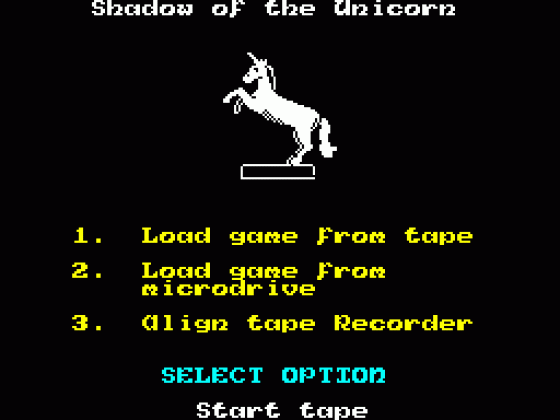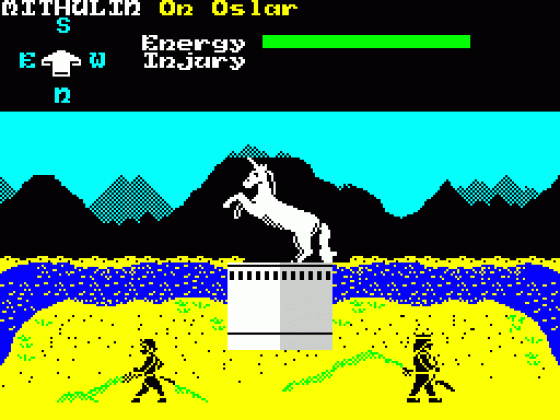
Crash
 1st January 1986
1st January 1986
Categories: Review: Software
Author: Derek Brewster
Publisher: Mikro-Gen
Machine: Spectrum 48K
Published in Crash #24
Shadow of The Unicorn
This latest game from Mikro- Gen has a lot to live up to. It has been hailed as the first Mikro-Plus game with an additional 16K memory supplied via a piece of hardware which plugs into the back of the Spectrum. This Mikro-Plus interface has a joystick port and so the game can be played with a joystick. This facility also allows copies to be transferred to tape or microdrive. Without a joystick the game plays well on a keyboard and on side two of the tape you receive with the game is a head alignment routine to ensure trouble free loading from your tape recorder.
Shadow of the Unicorn is the first piece of software to be actually marketed with a hardware add-on (Psyclapse and Bandersnatch from the old Imagine team never saw the light of day). The surprising thing about the game is its conspicuous lack of the sort of mind-blowing features one might expect from such an innovative breakthrough. The celebrated Lords of Midnight is now one and a half years old and it must be a sad reflection on games design when this game is far inferior in terms of basic structure than that first Midnight game.
The fundamental flaw in Unicorn is the curious state of affairs that has your character Iookin9, say, south when he is travelling west. The character is literally not looking where he is going! Were this not strange enough there is an added complication found when a character is in a town or village. He may be in a settlement but may only know it for sure after looking through all four compass directions. Getting to a village, castle or other distant object isn't as effective as in the true landscaping adventures, as, ignoring the virtually unchanging backdrop of distant mountains; you can only see the terrain of the adjacent square next to you in the viewing direction. You don't feel as if you are approaching them, you literally see them, you turn and move toward them and then that's it, you're on top of them, whether it be a castle or a windmill. Compare this to Lords of Midnight where you could aim for distant lakes and towers and you might see the point I'm making. In these games you get the impression that the towers, keeps etc. actually exist whereas here it is only too obvious that they are an artifice of computer memory. When considering some of the finer aspects of this game, these flaws in design may shrink somewhat but only when games such as Lords of Midnight and Runestone have temporarily slipped the mind.

It is not only in the area of games design where Mikro-Gen have me puzzled. The game is marketed with a (too) large booklet which is fashioned along Tolkien lines but, as in so many books and booklets that accompany adventures, falls somewhat short of the narrative powers of the great master himself. None but the final two chapters has any great relevance to the computer program.
You might think that a game which makes use of a new piece of technology would have a fine instruction booklet. Not a bit of it. This game has only a flimsy sheet of card giving you a very short summary of the story (much too short given the length of the book) and a few instructions concerning the hardware and its implications. I found on one occasion some difficulty in finding out exactly how to save a game and ended up loosing it, much to my chagrin as I had put in a long session and had progressed well. After the joystick controls (Left Right for movement, Up to take or drop, Fire to fight, Down to turn view to the right) you get a rather plain list of the characters with 1) Mithulin, King of Oronfal, 2) Avarath. Wizard of the Zim-Faranid, and 3) Holdin, Captain of Falforn up to 10) Lairmath, another Captain of Falforn. Not all of these characters hold equal sway in the stormy lands of Falforn and the royal lands of Oronfal. The three main characters are Mithulin the king of the royal lands, Rolquin queen of the storm lands and Avarath the wizard who is distinguished by his ability to fireball the irritating monkey-like figure who attacks characters willy-nilly throughout the entire course of the game (later research reveals this persistent assailant to be a nalesh).
Actually, while I'm about it, how about this tip for avoiding the pain in the neck nalesh. Because characters are safe unless you select to move them (there is no real-time element or any urgency with the other characters), and because the nalesh always attacks from the side of the screen furthest from you, avoid the beast by quickly flicking between characters as you move your chosen character across the screen. After only two or three flicks your character ends up being attacked by the nalesh from the wrong side of the screen leaving the character to peacefully leave the screen in the direction chosen and be happily on his or her way.
A convenient way to take you through the logistics of this game is to look at the screen which retains the same format throughout (and should be on this page somewhere unless the powers that be mix up the pictures as with Warlords/Red Moon). At the top left is the name of the character you are using at that particular time. Next to this name is the location you are passing through which generally is helpful enough to locate your approximate position on the map supplied with the game (if you are following one of the paths, or you have entered a castle, this position can be verified accurately). Below the name of the character presently playing is the com pass whose arrow does not indicate direction of travel but the viewing direction which only becomes the direction of travel if you swing it around to lie left or right on the screen. The yellow and red bars adjacent have variable lengths to represent generally decreasing energy and (thanks to the aforementioned pain in the necks) increasing injury. Decreasing energy is reversed on eating at one of the magical berry bushes which can be puzzlingly sparse when you really need them, and no doubt there exists some spell to undo the harm of injury. To take no action with either injury or energy can result in a character's death, and loosing an important character can see you starting a new game.
The standard of graphics in this game is rather puzzling given its added memory resources and its destiny as a mega-game. There are quite a number of heavy-handed colour clashes and one piece of animation has the king doing a sort of constipated break-dance. One thing you can do is hand it to the game for clever music effects; the music is in keeping with the game and is very tuneful indeed.
Shadow of the Unicorn is a very good game by any standards. It is complex, has a story-line which is worth the considerable effort getting to know and yet is instantly and enjoyably playable. The tone of this review has been F flat for one very significant reason; the game is costly due to the Mikro-Plus add-on necessary for the additional 16K the game offers. What is a little puzzling (even worrying) is just where this extra memory has been allocated, as the improvements such additions might bring are not immediately apparent.
Comments
Difficulty: the most difficult thing is reading the book
Graphics: good, but not as might have been expected
Presentation: simple and easy to get to terms with
Input facility: perhaps could have done with some textual information
Other Reviews Of Shadow of The Unicorn For The Spectrum 48K
The Shadow Of The Unicorn (Mikro-Gen)
A review by Steve Malone (Your Sinclair)
Shadow Of The Unicorn (Mikro-Gen)
A review by Chris Bourne (Sinclair User)
Shadow Of The Unicorn (Mikro-Gen)
A review









